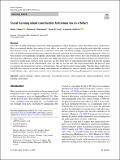Files in this item
Social learning about construction behaviour via an artefact
Item metadata
| dc.contributor.author | Breen, Alexis J. | |
| dc.contributor.author | Bonneaud, Clémence C. | |
| dc.contributor.author | Healy, Susan D. | |
| dc.contributor.author | Guillette, Lauren Mary | |
| dc.date.accessioned | 2019-02-14T17:30:04Z | |
| dc.date.available | 2019-02-14T17:30:04Z | |
| dc.date.issued | 2019-05 | |
| dc.identifier | 257443733 | |
| dc.identifier | b5515d11-7a21-4aed-9401-b1fc60549513 | |
| dc.identifier | 85061694897 | |
| dc.identifier | 000464719200002 | |
| dc.identifier.citation | Breen , A J , Bonneaud , C C , Healy , S D & Guillette , L M 2019 , ' Social learning about construction behaviour via an artefact ' , Animal Cognition , vol. 22 , no. 3 , pp. 305–315 . https://doi.org/10.1007/s10071-019-01240-x | en |
| dc.identifier.issn | 1435-9448 | |
| dc.identifier.other | ORCID: /0000-0002-8059-4480/work/60631327 | |
| dc.identifier.uri | https://hdl.handle.net/10023/17071 | |
| dc.description | Funding: UK Biotechnology and Biological Sciences Research Council (BB/M013944/1). | en |
| dc.description.abstract | One source of public information may be the enduring products of others’ behaviour, such as discarded tools or vacated nests. Here, we examined whether observation of a nest affects the material captive zebra finch males prefer when they construct their first nest. It does: for first-time nest construction, males that viewed only an empty cage preferred the colour of material each initially favoured but those males that had observed a pre-built nest of material of their non-preferred colour lost their material-colour preference altogether. Additionally, half of the males that viewed a nest were tested in an environment (the laboratory) different to that in which they were reared (an outdoor aviary). We had expected the aviary-reared (versus laboratory-reared) males would be more uncertain, and thus more likely to select material for their first nest that matched in colour to the colour of the ‘demonstrated’ nest—but this was not the case. The aviary-reared males did, however, tend to touch first the demonstrated colour of material more than did the laboratory-reared males. Together these results show that both observation of a nest and a change in environment can influence the material choices of novice builders. For naïve animal builders, then, construction artefacts can be information resources for learning about potential construction material. | |
| dc.format.extent | 11 | |
| dc.format.extent | 2000142 | |
| dc.language.iso | eng | |
| dc.relation.ispartof | Animal Cognition | en |
| dc.subject | Animal building | en |
| dc.subject | Animal construction | en |
| dc.subject | Construction artefacts | en |
| dc.subject | Nest construction | en |
| dc.subject | Material preference | en |
| dc.subject | Social learning | en |
| dc.subject | Zebra finch | en |
| dc.subject | QH301 Biology | en |
| dc.subject | DAS | en |
| dc.subject.lcc | QH301 | en |
| dc.title | Social learning about construction behaviour via an artefact | en |
| dc.type | Journal article | en |
| dc.contributor.sponsor | BBSRC | en |
| dc.contributor.institution | University of St Andrews. School of Biology | en |
| dc.contributor.institution | University of St Andrews. Centre for Biological Diversity | en |
| dc.contributor.institution | University of St Andrews. Centre for Social Learning & Cognitive Evolution | en |
| dc.contributor.institution | University of St Andrews. Institute of Behavioural and Neural Sciences | en |
| dc.identifier.doi | 10.1007/s10071-019-01240-x | |
| dc.description.status | Peer reviewed | en |
| dc.identifier.grantnumber | BB/M013944/1 | en |
This item appears in the following Collection(s)
Items in the St Andrews Research Repository are protected by copyright, with all rights reserved, unless otherwise indicated.

